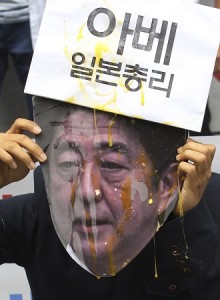Photo exhibit vividly captures brutality of war

A South Korean college student wearing a mask of Japanese Prime Minister Shinzo Abe is covered with eggs during a rally against Japan in front of the Japanese embassy in Seoul, South Korea, Wednesday, May 29, 2013. The brutality of war is depicted in hundreds of photographs that vividly capture the gruesome crimes during the Japanese invasion of Southeast Asia in the Second World War in the National Historical Commission of the Philippines. AP/Ahn Young-joon
MANILA, Philippines—Much has been said about the brutality of war but nothing can speak louder than hundreds of photographs that vividly captured the gruesome crimes during the Japanese invasion of Southeast Asia in the Second World War.
On exhibit at the National Historical Commission of the Philippines (NHCP) are some 260 photos from seven Asian nations—the Philippines, Korea, Malaysia, Singapore, China, Indonesia and Burma (Myanmar)—that tell stories of murder, torture, rape, slavery and decapitation between the 1930s and 1940s.
The photos were collected by Tulay Foundation Inc. (TFI), a nonprofit organization largely composed of Chinese-Filipinos in Manila.
In the face of current territorial conflicts in Asia, TFI chair Dorian Chua said their aim was “not to not to revive old wounds but solely to share the atrocious effects of war, learn important lessons, and forge friendship and peace for a better future.”
The exhibit was launched in partnership with the NHCP, Veterans Foundation of the Philippines, Wha Chi 48th Squadron MM Post and the Federation of Filipino-Chinese Chambers of Commerce and Industry (FFCCCI). It will be open to the public at the NHCP until Monday.
After its four-day run at the NHCP, the photo exhibit will be moved to the FFCCCI building in Binondo, Manila.
Japan has apologized for these atrocities several times.
NHCP Chairperson Maria Serena Diokno noted that more than half a century later, the whitewashing of these atrocities is still happening in Japan.
“These are incidents that are yet to be fully accepted by some parts of Japanese society,” Diokno said.
Barbaric as they may be, these are abuses we should never forget and events we ought to learn from, she said.
“We’re even lucky to have photos as proof of such crimes, unlike during the martial law period (when heinous human rights violations were also committed),” she said.
Most of the photos are from the Nanjing Museum in China, where around 300,000 were killed in a few weeks in what was later called “the Nanjing Massacre,” Chua said.
One photo from the museum sums up the exhibit, he said, pointing to a framed news clip about the infamous “Hundred Head Count,” a contest between two Japanese soldiers who beheaded more than a hundred each, 105 and 106, respectively. According to the Dec. 14, 1937, article in the Japanese newspaper Tokyo Daily News, it couldn’t be decided who reached the hundred-count first so the two soldiers continued the competition and set a new goal at 150.
The grim incidents of World War II were echoed in one photo to the next, from one nation to another, that even if the frames were grouped in boards assigned to each country, one wouldn’t be able to tell the difference. All the photographs spelled war—raw and real. Pictures showed clouds of smoke, roaring tanks and marching armies of Asian soldiers geared up for battle.
The photos show emaciated fighters in camps, women wriggling their way out of Japanese soldiers’ grips, naked women whose breasts were bayoneted, civilians about to be decapitated, a severed head displayed for everyone to see. Images of death abound, including those of children.
Mellowing out the morbid realities of war were pictures of grieving loved ones and countrymen at monuments built to honor the valor and heroism of soldiers, and to pay respects to the victims.
Exhibits like this allow the young to learn about a part of our history through the photos that are not usually seen in school textbooks and on the Internet, said Alay Buhay Rep. Weslie Gatchalian who attended the opening at the NHCP on Friday, along with war veterans and representatives from the Chinese community in the Philippines.
Chua criticized Japanese government officials for visiting shrines and honoring the perpetuators of these killings.
Only one Japanese national was at the exhibit opening. “I think this kind of exhibition could not be held in a national historical facility in Japan,” said the Japanese man at the event who requested anonymity for personal reasons.
“It is very painful for me to see these things,” the 25-year-old said.
It is unfortunate that most of the youth in Japan are not allowed to know about this grim period in history, he said, adding that he didn’t have any idea about the horrid details of the war in Asia until he went to college.
“This exhibit has been meaningful for me. Although, I have already seen most of the pictures here before, sometimes we need to see them over and over again and confront what really happened,” he said.
These are usually reported in a matter-of-fact tone, with hints of how strong Japanese soldiers were in China during that time, said the Japanese national.
The exhibit is being held as China and Japan currently exchange barbs over control of the Senkaku or Diaoyu Islands. The territorial conflict has resulted in mass protest actions on both sides.
China and the Philippines, on the other hand, have also been trading threats over territorial claims to small atolls and islets in the South China Sea which are believed to be rich in oil and gas.
